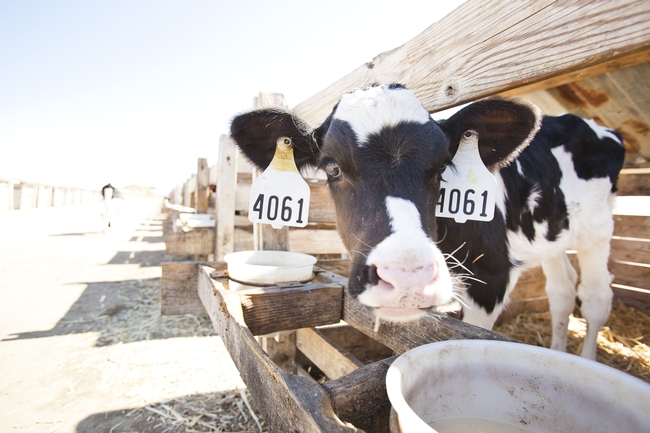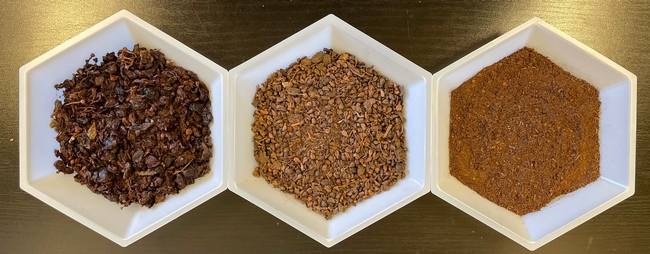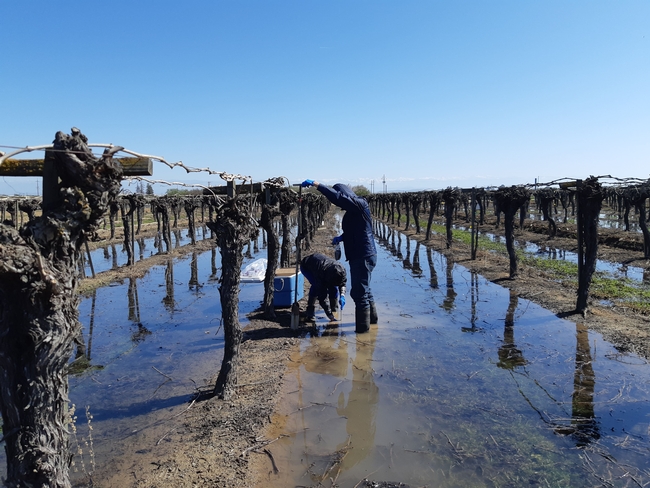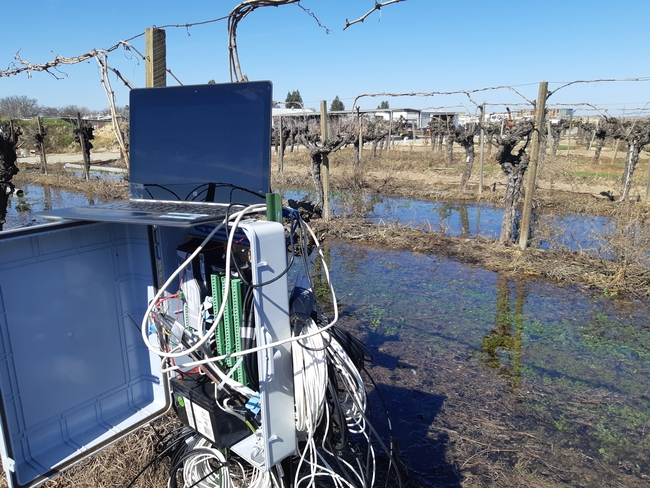
Posts Tagged: grape
Grape seeds, stems and skins can reduce dairy cattle emissions
Low-cost wine industry additive also improved feed efficiency and milk quality
Researchers at University of California, Davis, added fresh grape pomace left over from winemaking operations to alfalfa-based feed for dairy cows and found that methane emissions were reduced by 10% to 11%.
The preliminary findings could offer a low-cost sustainable pathway for vineyards to reduce waste while helping dairy operations maintain quality while cutting back on emissions of methane, which is a powerful greenhouse gas.
“This is the first time anybody has shown that this can work in California,” said Ermias Kebreab, an animal science professor and associate dean of global engagement at UC Davis. “You're reducing emissions, you're improving the quality and it may also reduce the cost of production.”
The pilot research project, which will be detailed in a paper later this year, also found that mixing in grape pomace improved feed efficiency and increased healthful fats, said Selina Wang, an associate professor of Cooperative Extension in small scale fruit and vegetable processing.
“We found that the feed with the additive of grape pomace changed the fatty acid composition of the milk and, in particular, increased the polyunsaturated fats, which are the main fats in grape pomace,” Wang said. “This suggests that supplementing the feed with an optimal fatty acid profile may have positive impact on the fatty acid profile of the milk and increase their health benefits.”
Symbiotic commodities?
In 2022, California was the leading dairy producer in the country, generating $10.40 billion in sales, while 90% of wine production came from the Golden State, with a market value of $5.54 billion.
Processing grapes for wine generates thousands of tons of waste in the form of grape pomace, which consists of leftover seeds, skins and stems. Dairy and livestock are responsible for more than half of the state's methane emissions, owed largely to cow burps.
They are the top two agricultural commodities in California, according to state production statistics, and reducing waste and emissions for both industries are key to the state meeting its climate goals.
Tannins for emission reductions
Wine grapes are high in fats and tannin, which is known to reduce methane emissions, so Kebreab sought to test if adding grape pomace to feed could have a positive effect while not adversely affecting production.
“It's a byproduct that's not being used much,” he said. “This is something that can be included in our efforts to try to reduce emissions.”
A mix of feed options
To do the research, scientists worked with Holstein dairy cows and gave the animals feed consisting of alfalfa, wheat, almond hulls, cottonseed and grain. After two weeks, the cows were split into three groups: A control group with no change in diet, another where the feed combination included 10% grape pomace and a third that received 15% grape pomace.
Every four weeks, the cow groups would change feed combinations.
They were fed twice daily by postdoctoral students and interns, and emissions were monitored daily. Milk production was documented in the morning and evening and milk samples were collected weekly to analyze for fat, protein, lactose and other measurements, which showed no differences between the control and other groups.
Methane and hydrogen emissions were reduced compared with the control group, suggesting that grape pomace reduced enteric emissions without affecting production.
“I think the dairy industry will be very interested in this,” Kebreab said. “Sometimes when you're using additives, they have palatability issues. With grape pomace, they absolutely love it.”
Next on the list is a trial with olive pomace and working to understand the mechanism that reduces emissions. “If we have a better understanding of the mechanisms, we can select the feed additive or a mix of feed additives to reduce dairy cattle emissions and make dairy milk healthier while making use of the agriculture byproducts,” Wang said. “There's a lot of room to grow in this space and we're excited about this work.”
The research was supported by the California Dairy Research Foundation.
This article was first published on the UC Davis news site.
Tree and vine fall weed management
The 2023 post-harvest season is upon us and it's time to prep for your fall/winter weed control...
Study offers insights on reducing nitrate contamination from groundwater recharge
Light irrigation before flooding stimulates microbes to remove nitrates from soil
With California enduring record-breaking rain and snow and Gov. Gavin Newsom recently easing restrictions on groundwater recharge, interest in “managed aquifer recharge” has never been higher. This process – by which floodwater is routed to sites such as farm fields so that it percolates into the aquifer – holds great promise as a tool to replenish depleted groundwater stores across the state.
But one concern, in the agricultural context, is how recharge might push nitrates from fertilizer into the groundwater supply. Consumption of well water contaminated with nitrates has been linked to increased risk of cancers, birth defects and other health impacts.
“Many growers want to provide farmland to help recharge groundwater, but they don't want to contribute to nitrate contamination of the groundwater, and they need to know how on-farm recharge practices might affect their crops,” said Matthew Fidelibus, a University of California Cooperative Extension specialist in the UC Davis Department of Viticulture and Enology.
A recently published study by UC scientists sheds new light on how nitrates move through an agricultural recharge site and how growers might reduce potential leaching. Researchers analyzed data from two grapevine vineyards at Kearney Agricultural Research and Extension Center in Fresno County – one flooded for two weeks, and other for four.
Understanding initial nitrate levels crucial
A key factor in mitigating contamination is understanding how much nitrate is in the soil at the outset, said study author Helen Dahlke, a UC Davis hydrologist and leader of UC Agriculture and Natural Resources' strategic initiative on water. In areas with little precipitation and cropping systems that require greater amounts of synthetic fertilizer, the accumulation of residual nitrate – resulting from nitrogen in the fertilizer not taken up by the plants – can be quite high.
“The percentage of nitrates in some soils can really increase over the years, particularly if you have many dry years in a row where you don't have access to irrigation water or natural precipitation flushing some of those nitrates out of the soil,” Dahlke said.
While intense rains in recent weeks have helped dilute nitrate concentrations naturally, farmers looking to participate in recharge during the dry years ahead should consider flooding their fields with greater volumes of water.
“If you're doing this for the first time – on-farm recharge in the winter – check your residual soil nitrate levels because if they're very high, you should apply a lot of water in order to make sure that the residual nitrate is diluted down,” said Dahlke, who also added that growers should check their soil properties for suitability of recharge projects.
She recommended using, as a “good first approximation,” the online Soil Agricultural Groundwater Banking Index map, a project led by Toby O'Geen, a UC Cooperative Extension soil resource specialist.
Researchers looking at other ways to reduce nitrates
Even before flooding the fields for recharge, there are several practices that can lower initial nitrate levels and risk of leaching. Cover crops such as alfalfa and triticale, for example, can help take up residual nitrates that accumulate from fertilizing a main crop over time.
Dahlke and Fidelibus – a co-author of the San Joaquin Valley vineyard study – both pointed to pre-flooding irrigation that encourages denitrification, a process in which soil microbes transform nitrates into gaseous forms of nitrogen.
“Those denitrifying microbes need to be stimulated to do the work,” said Dahlke. “What we have found is that if you do a little bit of irrigation before you start the flooding, increasing the soil moisture can get those microbes started and they can take out more nitrate from the soil.”
The timing and quantity of fertilizer applications are also major factors in reducing leaching. Although more growers are following high-frequency, low-concentration practices to maximize uptake by crops, Dahlke said there needs to be more emphasis on incorporating nitrogen transformation processes – such as denitrification – in the nutrient management guidelines that farmers follow.
“Implementing thoughtful nutrient management plans will play a particularly important role in participating farms,” Fidelibus added.
A more holistic view of groundwater recharge
In short, choices made during the growing season can affect those in the winter recharge season – and vice versa. For example, applying compost or other organic amendments to soil can give microbes the “fuel” they need for sustained denitrification.
“What we have found is that our denitrifying bacteria often run out of steam because they don't have enough carbon to do the work,” Dahlke said. “Like us, microbes need energy to do the work, and for microbes this energy comes from soil carbon.”
Then, adding moisture via recharge to that field with high organic content can stimulate mineralization and nitrification, processes in which microbes transform the organic nitrogen into ammonium – and subsequently nitrates – that the plants can then take up. Those naturally occurring nitrates would thus reduce the need for the grower to apply synthetic fertilizer.
“The winter on-farm recharge experiments have shown that altering the moisture regime in the winter has consequences for the nitrogen budget in the summer growing season,” Dahlke explained. “Theoretically, what we need to be doing is better integrating both seasons by keeping an eye on the soil-nitrogen balance across the whole year so that we can ensure, at the end of the growing season, the residual nitrate in the soil is minimized.”
The study, published in the journal Science of The Total Environment, was part of the post-doctoral work of former UC Davis researcher Elad Levintal. In addition to Fidelibus and Dahlke, other authors are Laibin Huang, Cristina Prieto García, Adolfo Coyotl, William Horwath and Jorge Rodrigues, all in the Department of Land, Air and Water Resources at UC Davis.
The Achemon Sphinx Moth: A Lovely Beast, Indeed
It is indeed a “lovely beast,” as lepidopterist Art Shapiro, UC Davis...
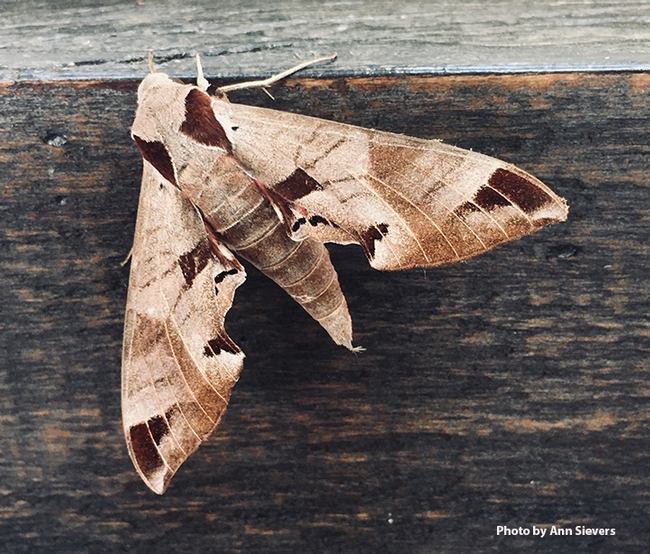
Eumorpha achemon, the Achemon Sphinx, is a "lovely beast," says UC Davis distinguished professor Art Shapiro. Ann Sievers, owner, grower and miller Il Fiorello Olive Oil Co., recently found this one the wall of her patio. (Photo by Ann Sievers)
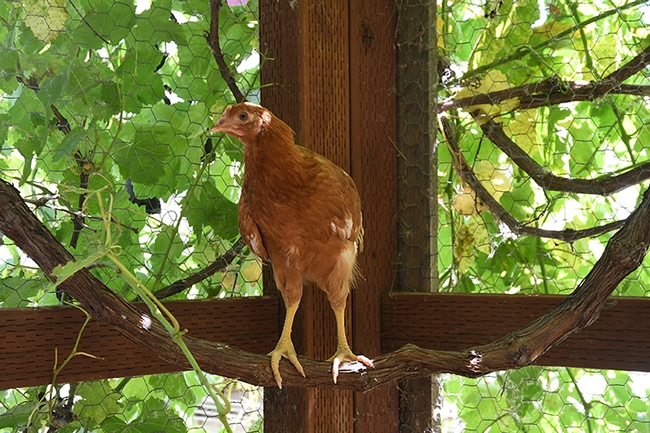
What's for lunch? A chicken in one of Ann Sievers' flocks at Il Fiorello Olive Oil Co., eyes the photographer. Chickens eagerly eat lots of bugs--if they're available. The larvae of the Achemon Sphinx moth feed on grape leaves. (Photo by Kathy Keatley Garvey)
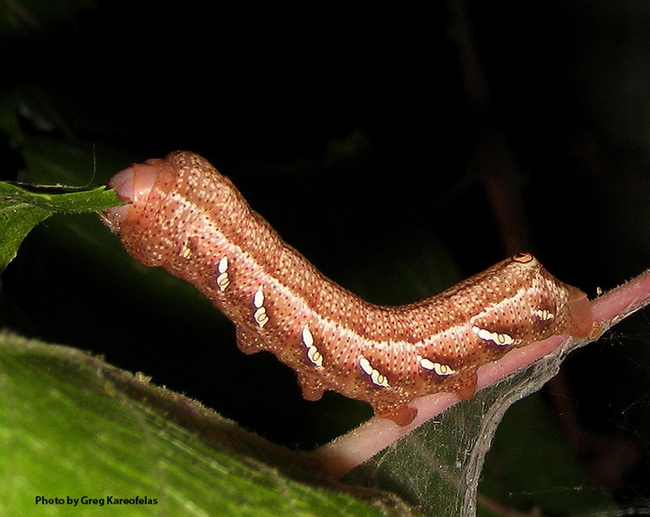
Naturalist-photographer Greg Kareofelas took this image of an Eumorpha achemon larva in his yard in Davis several years ago. It was feeding on native grape, Vitus californica. (Photo by Greg Kareofelas)
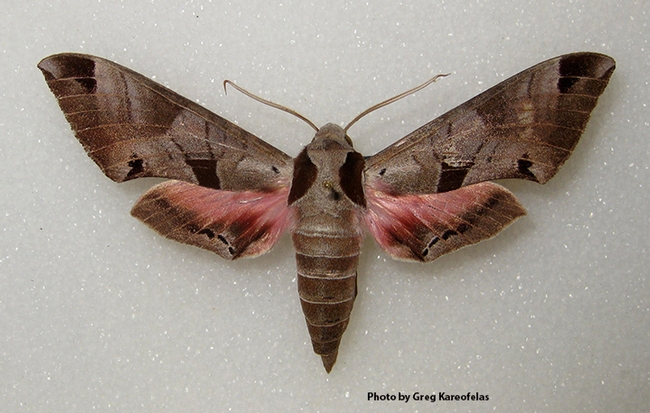
An adult Eumorpha achemon, photographed by naturalist-photographer Greg Kareofelas in his yard in Davis several years ago. It was feeding on native grape, Vitus californica. (Photo by Greg Kareofelas)
Kearney trial could reveal the next great white wine
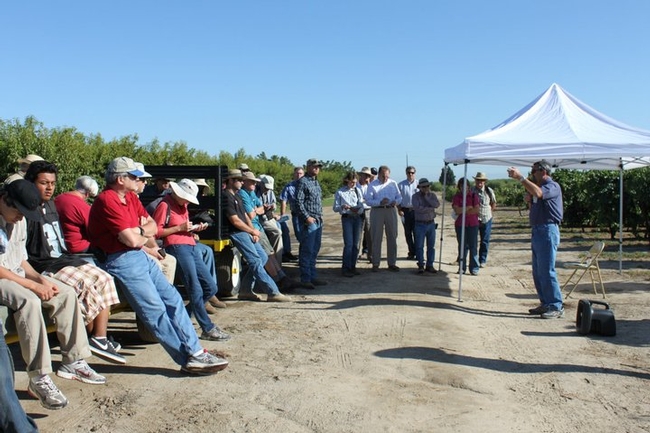
Proposed Green Tech High School Academy draws critics
Jennifer Bonnett, Lodi News Sentinel
Lodi Unified School District has proposed developing a Green Tech High School Academy, the first of its kind in California. The district has already spent hundreds of hours and thousands of dollars laying the groundwork for a new school that some trustees say they can’t support. Parent Paul Verdegaal called it the wrong idea at the wrong time. “It appears that LUSD is once again chasing pipe dreams at great cost in money and opportunities for students to actually learn, especially with reduced budgets," he said. The article noted that Verdegaal is a farm adviser for the University of California Cooperative Extension in San Joaquin County. Verdegaal said he sees students who don’t understand science or math, key subjects in creating sustainable practices.
This year's olive harvest is the pits
Martin Espinoza, The Press Democrat
Sonoma County olive growers are bracing for a disastrous harvest, one that could wipe out the supply of fresh local olive oil. Paul Vossen, a farm advisor with the University of California Cooperative Extension, said that in an average low-yield year olive orchards produce 50 to 60 percent less. “We have some places where they have almost nothing,” he said.

